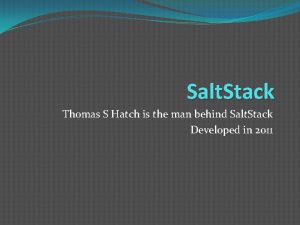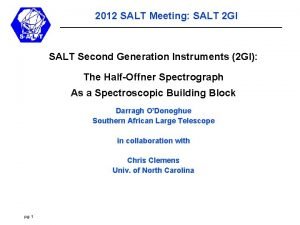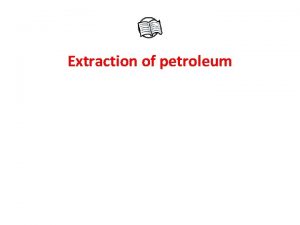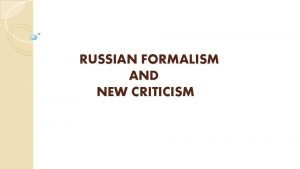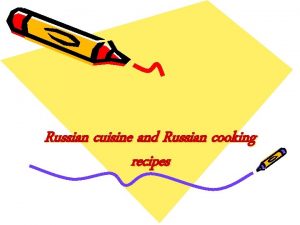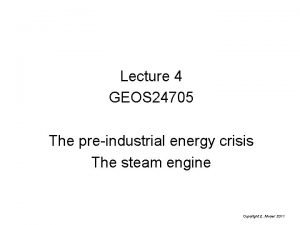PreIndustrial Energy Management in the Russian Salt Extraction












- Slides: 12

Pre-Industrial Energy Management in the Russian Salt Extraction Industry. Alexei Kraikovski, EU SPb. Margarita Dadykina, HSE.

Plan Introduction The spatial structure of the forest and the problem of energy abundance. Practices of energy consumption. Economy of energy consumption. Discussion and conclusion.

Introduction The main question: how relatively small Russian Nation could colonize and manage enormous territories with harsh climate, being surrounded with rather unfriendly neighbors and having very limited access to the latest advanced technologies? Abundance of energy and its consequences. How could we estimate the energy capacity of the Russian forests and were the people of that time able to do that? Is it possible to take into consideration the problem of availability of energy for the consumers? What amount of energy was required for the Russian economy? What was the economic effect of the energy? In other words, was it cheap or expensive? Was it able to generate significant profits on the market?

Introduction. Starting point. The energy management of the Dutch Golden Age. Peat, wind, water, timber, what else? “how so small a population… could manage to play leading parts on almost every scene of human activities” (De Zeeuw, 'Peat and the Dutch golden age' ).

Introduction. Sources. Spaso-Prilutsky monastery, accounting books of the salt service in Sol Vychegodskaya. Important resource – detailed records. Well structured and very clear. 1640 s – salt taxation reform. Heyday of the salt boiling in the area.

Forest and energy. we have to make clear distinction between the total amount of energy, concentrated in the nearby forest, and the accessible energy.

Energy consumption Year cycle – from flood to flood. Total annual operation – 20 – 22 periods of 12 days each. RAFT – what does it mean? D = 0, 2 m. 1 m. wide. Ca. 40 m 3 10 sazhen (21, 3 m. ) long 1 sazhen (2, 13 m. ) high 5 diameters of average trunk wide.

Energy consumption. Volumes. 6000 m 3 per year for one oven = 3000 tons (500 kg. x 6000 m 3). Total consumption of peat energy in the 6 kg Golden Age Netherlands: 3, 6 kcalx 3 x 10 = 9 kcal. (de Zeeuw). 6 6 x 10 10, 8 x 10 kcal. For one oven.

Energy consumption. Economy. 1, 2 – 1, 3 m 3 of timber per 1 pood (16, 38 kg. ) of salt = 2, 5 x 103 kcal cost 5 kop. , 1 pood of salt brings 10 kop. 1 kcal timber=0, 0024 kop. 1 man=516 kcal per day (de Zeeuw) 4 workersx 12 days=3, 8 rub. 1 pood takes 96 kcal of human energy=1, 6 kop. 1 kcal man=0, 015 kop.

1. maintenance energy, needed for food, clothing and shelter; 2. heating energy, domestic uses and for the heating of materials in Conclusion andfordiscussion manufacturing operations; 60 ha per one oven per year=18 3. a. stationary motion energy. sq. km for 30 ovens existing in 3. b. mobile motion energy, for carrying Sol or dragging loads, for plowing Vychegodskaya in the 17 th c. etc. Deforestation and problem of accessibility. (de Zeeuw). Infrastructure as the link from the natural object to the natural resource. Technologies and the transformation of energy. Russian industrialization through the perspective of inexhaustible(? ) energy and relatively expensive human expertise. The question of accessaibility of labor force and natural resources. 5 – 6 mln. People in the late 17 th c. (Y. Vodarskiy).

Questions Critical distance from the streaming water to make the trees fuel? The dynamic of deforestation in the salt-boiling regions through the perspective of energy. International comparative perspective (the Netherlands? Great Britain? ). The problem of efficiency?

Thank you for your attention
 Describe preindustrial societies of horticulturalists.
Describe preindustrial societies of horticulturalists. Energy energy transfer and general energy analysis
Energy energy transfer and general energy analysis Energy energy transfer and general energy analysis
Energy energy transfer and general energy analysis Salt linux management
Salt linux management Hát kết hợp bộ gõ cơ thể
Hát kết hợp bộ gõ cơ thể Lp html
Lp html Bổ thể
Bổ thể Tỉ lệ cơ thể trẻ em
Tỉ lệ cơ thể trẻ em Chó sói
Chó sói Glasgow thang điểm
Glasgow thang điểm Alleluia hat len nguoi oi
Alleluia hat len nguoi oi Môn thể thao bắt đầu bằng từ chạy
Môn thể thao bắt đầu bằng từ chạy Thế nào là hệ số cao nhất
Thế nào là hệ số cao nhất



